Related Research Articles

The smallmouth bass is a species of freshwater fish in the sunfish family (Centrarchidae) of the order Perciformes. It is the type species of its genus Micropterus, and is a popular game fish sought by anglers throughout the temperate zones of North America, and has been spread by stocking—as well as illegal introductions—to many cool-water tributaries and lakes in Canada and more so introduced in the United States. The maximum recorded size is approximately 27 inches (69 cm) and 12 pounds (5.4 kg).
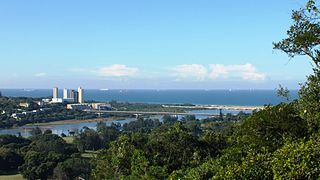
The Umgeni River or Mgeni River is a river in KwaZulu-Natal, South Africa. It rises in the "Dargle" in the KZN Midlands, and its mouth is at Durban, some distance north of Durban's natural harbour. It is generally agreed its name means "the river of entrance" in Zulu, though other meanings have been suggested.
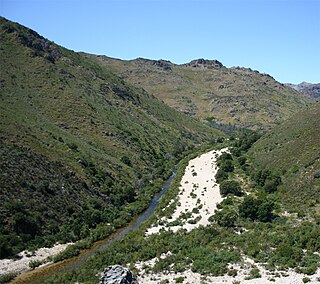
The Olifants River is a river in the northwestern area of the Western Cape Province of South Africa. The upper and main catchment area of the Olifants river is around Ceres and the Cederberg mountains. The Clanwilliam and Bulshoek dams are located on the river and provide water for the towns and farms along the watercourse. The river is approximately 285 km long with a catchment area of 46,220 km2 and flows into the Atlantic Ocean at Papendorp, 250 km north of Cape Town.

Leptobarbus is a genus of cyprinid fish that are native to freshwater habitats in Southeast Asia. They are important food fish. It is the only genus in the subfamily Leptobarbinae. Leptobarbus hoevenii or "sultan fish" migrate the fresh water rivers of Malaysia and travel at the surface in schools of 40-80 individuals at speeds of 0.48-1.08 km. Acid-soluble collagen (ASC) and pepsin-soluble collagen (PSC) were extracted from the muscles of selected cultured catfish, red tilapia, black tilapia, pangasius catfish, sultan fish and labyrinth fish, freshwater fishes that are widely consumed in Malaysia. The extracted yields for the tested species were higher for PSC as compared with ASC.
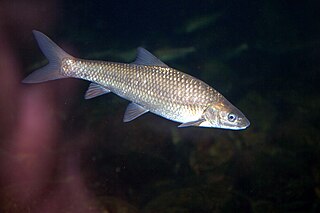
The Cape whitefish or Berg-breede River whitefish is a ray-finned fish species in the family Cyprinidae. It was formerly placed with the South African redfins in Pseudobarbus. It is tetraploid. Its closest living relative is the sawfin.

The Clanwilliam yellowfish is a ray-finned fish species in the family Cyprinidae. It has long been placed in Barbus, the "wastebin genus" for barbs, by default; however, the species is increasingly being restored to related yellowfish genus Labeobarbus which seems a much more appropriate placement. It is hexaploid like the other yellowfish, among which it is more closely related to the smallscale yellowfish than to the largescale yellowfish.

The largemouth yellowfish or Vaal-Orange largemouth yellowfish is a ray-finned fish species in the family Cyprinidae. This large freshwater barb is found in southern Africa.
Lake Tshangalele, also known as Lake Lufira or Mwadingusha Reservoir, is an artificial lake in the south-east of the Democratic Republic of Congo. It is located about 20 km east of the city of Likasi in the old province of Katanga. It lies at about 1,100 m above sea-level in a large depression surrounded by low mountains. It was created by a dam built on the Lufira River near Mwadingusha in 1926 to provide hydro-electric power. The area of open water is about 362.5 km2. During the wettest months of February and March, the area flooded reaches a maximum of 440 km2. The lake is shallow with a mean depth of only 2.6 m.

The fishing industry in the land-locked country of Laos is a major source of sustenance and food security to its people dwelling near rivers, reservoirs and ponds. Apart from wild capture fisheries, which is a major component of fish production, aquaculture and stocking are significant developments in the country. Historically, fishing activity was recorded in writings on the gate and walls of the Wat Xieng Thong in Luang Prabang dated 1560. For many Laotians, freshwater fish are the principal source of protein. The percentage of people involved in regular fishing activity is very small, only near major rivers or reservoirs, as for most of the fishers it is a part-time activity.

Oviston Nature Reserve is a protected area in the Eastern Cape Province, South Africa. The nature reserve is managed by Eastern Cape Parks. It is located on the southern shores of the Gariep Dam.
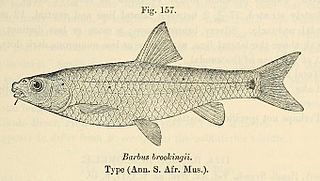
The border barb is a ray-finned fish species in the family Cyprinidae. It is the only species in the genus Amatolacypris. Like Pseudobarbus, it is tetraploid.
Klerkskraal Dam is a combined gravity and arch type dam located on the Mooi River, near Ventersdorp, North West, South Africa. It was established in 1969 and its main purpose is to serve for irrigation. The hazard potential of the dam has been ranked high (3). The dam is also a well known bass fishing destination in the region.
Klipdrif Dam is an earth-fill type dam located on the Loopspruit and Enselspruit near Potchefstroom, North West, South Africa. The river flowing out the dam is the Loopspruit. It was established in 1990 and its primary purpose is to serve for irrigation. The hazard potential of the dam has been ranked significant (2).

The Motlatse River, Blyde River, or Umdhlazi River is a river in the Mpumalanga and Limpopo provinces of South Africa. It has a northwards course in steep-sided valleys and ravines of the Mpumalanga Drakensberg, before it enters the lowveld region of the Limpopo province. It has its ultimate origins at around 2,000 m altitude in the Hartebeesvlakte conservation area, to the north of Long Tom Pass. It runs through the Blyde River Canyon.
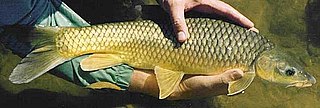
The smallmouth yellowfish is a species of ray-finned fish in the genus Labeobarbus. It has become an invasive species in rivers of the Eastern Cape, South Africa, such as the Mbhashe River.
The Mooi River is a river in North West Province, South Africa. It is a tributary of the Vaal River and belongs to the Upper Vaal Water Management Area.
Donaldson Dam is a dam next to the township Bekkersdal along the Wonderfonteinspruit. It comprises 2 reservoirs - the Top lake and the Bottom lake. Its water has been heavily polluted by acid mine runoff on the upper Wonderfonteinspruit and sewage from nearby Bekkersdal.
Wonderfonteinspruit is a small river situated in the Highveld region of South Africa. Its source has been disputed in the past, although it is now accepted that the river originates in the West Rand of Gauteng between Krugersdorp and Randfontein, at the Tudor Dam, which was initially used as a storage dam for the Luiperdsvlei Gold Plant. In the past the river received a majority of its water from karst springs along its course. The river flows through one of the richest gold-producing areas in the world, which led to the dolomitic compartments which fed the river being dewatered to make way for mining activities. This led to the drying up of the karst springs that fed the river.
Kromelmboogspruit is a tributary of the Vaal River in the Free State, which is part of the Orange River drainage basin. It is found near Heilbron and flows upwards in a north-westerly direction to drain into the Vaal between Parys and Sasolburg.
References
- ↑ "Boskop RQS Dams". Department of Water Affairs, Republic of South Africa. 21 May 2004. Archived from the original on 19 June 2004.
- ↑ "Dam Safety Office 2010/2011 Annual Report" (PDF). Department of Water Affairs, Republic of South Africa. p. 23. Archived from the original (PDF) on 2022-10-23. Retrieved 2013-06-11.
- ↑ "Boskop Dam Nature Reserve". Dr Kenneth Kaunda District, North West Parks & Tourism Board. Archived from the original on 14 January 2012.
- ↑ "northwestparks.co.za". Archived from the original on 2018-09-17.
- ↑ "Fish mark-recapture study at Boskop dam" (PDF).
- ↑ The period during which the study was taken was unfavourable for clarias gariepinus numbers as it was just after spawning so the majority of the fish were still too small to be netted.
- ↑ These numbers have increased since the study, as the study was performed not too long after the micropterus Dolomieu was stocked in the dam.
- ↑ "Jacobs FJ Chapt. 2" (PDF).
- 1 2 (Koch and Schoonbee, 1975).
- ↑ Bredenkamp, G.J.; Bezuidenhout, H.; Joubert, H.; Naude, C. (1994-09-24). "The vegetation of the Boskop Dam Nature Reserve, Potchefstroom". Koedoe. 37 (1). doi: 10.4102/koedoe.v37i1.323 . ISSN 2071-0771.
- ↑ Records written in journal at dam office
- 1 2 3 "boskop yacht club". Archived from the original on 2017-05-13.